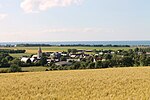Ver-sur-Mer

Ver-sur-Mer (French pronunciation: [vɛʁ syʁ mɛʁ] , literally Ver on Sea) is a commune in the Calvados department and Normandy region of north-western France. It is situated at the eastern end of Gold Beach between Arromanches and Courseulles. The town lies 20 km north-west of Caen and 14 km north-east of Bayeux. As well as its beach, the village has a bakery, pony club, sailing club, shrimp fishery, small supermarket, tennis court, and youth hostel. It is also home to the America Gold Beach Museum. Ver-sur-Mer lighthouse, still active today, was built in 1908 on the heights above the beach. During World War II, Canadian troops swiftly seized the lighthouse; however, it was badly damaged and had to be restored after the end of the war. Ver-sur-Mer's church, which was constructed between the 10th and 12th centuries, is dedicated to Saint Martin.
Excerpt from the Wikipedia article Ver-sur-Mer (License: CC BY-SA 3.0, Authors, Images).Ver-sur-Mer
Rue des Stins, Bayeux
Geographical coordinates (GPS) Address Nearby Places Show on map
Geographical coordinates (GPS)
| Latitude | Longitude |
|---|---|
| N 49.3319 ° | E -0.5283 ° |
Address
Rue des Stins 3
14114 Bayeux
Normandy, France
Open on Google Maps









